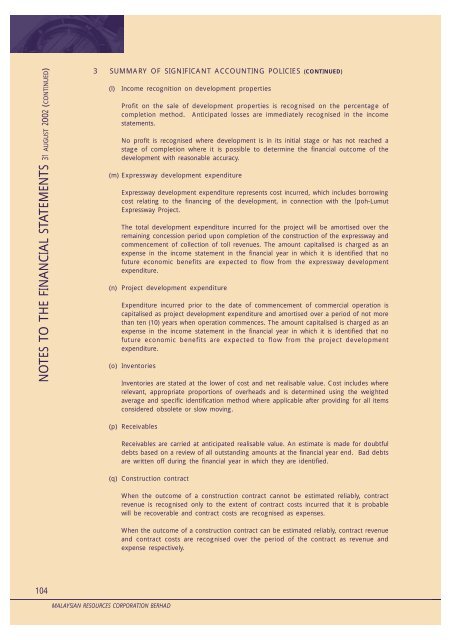cover rationale - ChartNexus
cover rationale - ChartNexus
cover rationale - ChartNexus
You also want an ePaper? Increase the reach of your titles
YUMPU automatically turns print PDFs into web optimized ePapers that Google loves.
NOTES TO THE FINANCIAL STATEMENTS 31 AUGUST 2002 (CONTINUED)<br />
104<br />
3 SUMMARY OF SIGNIFICANT ACCOUNTING POLICIES (CONTINUED)<br />
(l) Income recognition on development properties<br />
MALAYSIAN RESOURCES CORPORATION BERHAD<br />
Profit on the sale of development properties is recognised on the percentage of<br />
completion method. Anticipated losses are immediately recognised in the income<br />
statements.<br />
No profit is recognised where development is in its initial stage or has not reached a<br />
stage of completion where it is possible to determine the financial outcome of the<br />
development with reasonable accuracy.<br />
(m) Expressway development expenditure<br />
Expressway development expenditure represents cost incurred, which includes borrowing<br />
cost relating to the financing of the development, in connection with the Ipoh-Lumut<br />
Expressway Project.<br />
The total development expenditure incurred for the project will be amortised over the<br />
remaining concession period upon completion of the construction of the expressway and<br />
commencement of collection of toll revenues. The amount capitalised is charged as an<br />
expense in the income statement in the financial year in which it is identified that no<br />
future economic benefits are expected to flow from the expressway development<br />
expenditure.<br />
(n) Project development expenditure<br />
Expenditure incurred prior to the date of commencement of commercial operation is<br />
capitalised as project development expenditure and amortised over a period of not more<br />
than ten (10) years when operation commences. The amount capitalised is charged as an<br />
expense in the income statement in the financial year in which it is identified that no<br />
future economic benefits are expected to flow from the project development<br />
expenditure.<br />
(o) Inventories<br />
Inventories are stated at the lower of cost and net realisable value. Cost includes where<br />
relevant, appropriate proportions of overheads and is determined using the weighted<br />
average and specific identification method where applicable after providing for all items<br />
considered obsolete or slow moving.<br />
(p) Receivables<br />
Receivables are carried at anticipated realisable value. An estimate is made for doubtful<br />
debts based on a review of all outstanding amounts at the financial year end. Bad debts<br />
are written off during the financial year in which they are identified.<br />
(q) Construction contract<br />
When the outcome of a construction contract cannot be estimated reliably, contract<br />
revenue is recognised only to the extent of contract costs incurred that it is probable<br />
will be re<strong>cover</strong>able and contract costs are recognised as expenses.<br />
When the outcome of a construction contract can be estimated reliably, contract revenue<br />
and contract costs are recognised over the period of the contract as revenue and<br />
expense respectively.

















